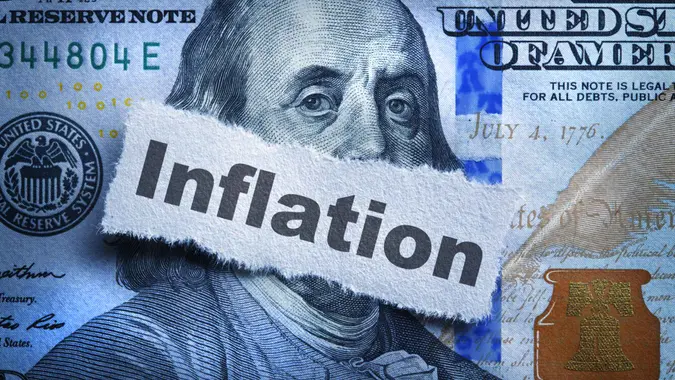Follow This Dave Ramsey Rule To Reduce Your Debt Much Faster

Commitment to Our Readers
GOBankingRates' editorial team is committed to bringing you unbiased reviews and information. We use data-driven methodologies to evaluate financial products and services - our reviews and ratings are not influenced by advertisers. You can read more about our editorial guidelines and our products and services review methodology.

20 Years
Helping You Live Richer

Reviewed
by Experts

Trusted by
Millions of Readers
Getting out of debt can be challenging and complex. Short of making minimum payments to chip away at your credit card bills or earning extra money through a side gig, just how do you avoid the dreaded debt collector?
Dealing with debt is different for everyone, but the second step in Dave Ramsey’s debt management plan is one approach to getting out from under the weight of car loans, credit card debt and high interest rates. Let’s examine Ramsey’s method and how it can help you cut your debt quickly.
The Snowball Method
The meat of Ramsey’s famed “Baby Steps” strategy is neatly packaged into the second stage of his program: The Debt Snowball. The name not only makes the thought of lowering debt seem more fun and interesting, but it’s also practical and — more importantly — simple.
Ramsey argues that debtors need to feel a sense of accomplishment with multiple small wins, as opposed to one large win, to be motivated to move forward in their debt-reduction goals. Here are his key takeaways as outlined on Ramsey Solutions:
- The debt snowball method uses the snowball effect to build momentum by paying off debts from the smallest amount to largest amount, as opposed to those with the highest interest rates first.
- Each time you pay off a debt, you roll that payment into the next one, speeding up your progress.
- The debt snowball method creates behavior change through motivation and consistency, helping you stay focused as you eliminate debt.
“The math seems to lean more toward paying the highest interest debts first, but what I have learned is that personal finance is 20% head knowledge and 80% behavior,” Ramsey explained.
How Ramsey’s Snowball Method Works
The debt snowball method that Ramsey champions encourages people to start paying down their smallest credit balance first. The maximum payment your personal finances will reasonably allow (without falling into bad standing with other bills and debts) is directed toward paying off the smallest debt balance, while the minimums due on all other debt obligations are paid in the meantime.
If you have two or more accounts with equal balances, Ramsey then recommends prioritizing the one with the higher interest rate. Once the first debt is fully paid off, the debt snowball continues with its forward momentum to pay down the next smallest debt you owe. However, this time, the payment you had once allotted to the first debt is now rolled into the next one on the list.
In the end, you will have paid off your debt relatively quickly, depending on how much you owe, and can start building wealth in the later Baby Steps.
5 Things To Remember When You Debt Snowball
The debt snowball approach is straightforward, but sometimes your natural inclinations, or behaviors as Ramsey puts it, are often what impede visible progress in debt management and reduction. So here are five behaviors to focus on.
1. Stop Adding to Your Debt
One of the precursors to applying the debt snowball to your finances is to stop adding to your debt. Ramsey recommends you steer clear of taking on more lines of credit to not only save your credit score but also help limit your monthly payments. However, keep in mind that there are special circumstances when using a credit card can be financially advantageous (as long as you pay off the balance monthly).
2. Automate Utility Bills
Bill payment automation is another technique that many financial gurus recommend. With these non-debt obligations being taken care of in the background, you can fully focus your efforts on the task at hand: paying off debt. You’ve got enough to think about.
3. Organize Your Debts
Sometimes, there are just too many debts to remember off the top of your head, and this tally could include everything from student loans to your monthly mortgage payments.
Broad estimations simply don’t make your debts tangible enough to care about. To ensure you’ve covered every corner of your debt problem, make sure to keep a spreadsheet or handwritten list of your active credit accounts, how much you owe, their interest rates and payment due dates. After closing an account, revisit the list so the information is refreshed in your mind, and update it as needed.
4. Focus on One Debt at a Time
As tempting as it is to allocate higher payments to as many accounts as possible, resist the urge to do so. Spreading your funds around, instead of focusing on a single account at a time, only dilutes your efforts. Like Ramsey says, you need small wins to keep yourself motivated.
5. Roll Over Payments to the Next Debt
If you’ve successfully managed to pay off a debt, congrats! But don’t confuse the funds you’ve freed from one debt as wiggle room in your monthly budget. The biggest success stories of the debt snowball plan commit these funds to their next smallest debt until their total owed is a happy, healthy zero.
Jennifer Calonia contributed to the reporting for this article.
 Written by
Written by  Edited by
Edited by 


























